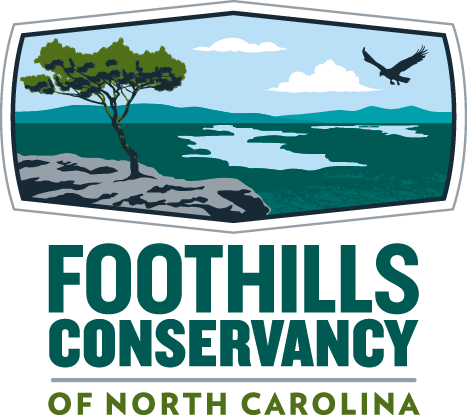Foothills Conservancy and North Carolina State Parks complete first phase of Bobs Creek State Natural Area acquisition in McDowell County
On January 23, Foothills Conservancy of North Carolina and North Carolina State Parks completed the first land purchase, about 1,500 acres, for the new Bobs Creek State Natural Area in southeastern McDowell County. Located just over three miles from the Town of Marion, the new state natural area will eventually be open for public hiking and other passive recreation uses.Over the course of several years, a conservation enthusiast purchased 6,000 acres of land in McDowell County with the intention of permanently protecting the land and allowing public access. Through a bargain sale to Foothills Conservancy and North Carolina State Parks, the first 1,500 acres are now permanently conserved.North Carolina State Parks will own and manage the land, including an area known as Bobs Pocket Wilderness, but not as a traditional state park. While a State Natural Area still falls under the jurisdiction of State Parks, there are important distinctions between the two.“A state park typically includes a visitor center and amenities for various recreation opportunities,” said Tom Kenney, land protection director of Foothills Conservancy. “A state natural area is a less developed recreation option.” While they do not include campgrounds and picnic areas, State Natural Areas allow for low-impact public uses, such as hiking and scientific research.“The purpose of a State Natural Area is to preserve the area in its natural condition,” said Brian Strong, chief of planning and natural resources for the North Carolina Division of Parks and Recreation. “State Natural Areas receive only such development as is necessary to preserve and protect their natural values, protect public health, and provide adequate interpretive programs. Bobs Creek State Natural Area contains a large expanse of forested lands dominated by acidic cove, oak-hickory and chestnut oak forests, and several rare plant species.”According to Strong, the property was once managed by a timber company that protected several hundred acres as a “pocket wilderness.” The pocket wilderness was open to the public for hiking, wildlife viewing, and camping. With its recent transition to state ownership, the property’s purpose comes full circle. “The Division will begin to develop access locations and hiking trails so the public can once again enjoy this unique wilderness,” Strong said.Funding for the first phase of the project came from a number of public and private sources. North Carolina’s Clean Water Management Trust Fund (CWMTF) granted $1.2 million to the initial acquisition and recently awarded another $1.2 million for the second phase: acquisition of an additional 2,000 acres scheduled for completion in 2019. CWMTF was established by the General Assembly in 1996 as a non-regulatory organization with a focus on protecting and restoring the State’s land and water resources. CWMTF awards grants to nonprofit and governmental organizations to protect land for natural, historical and cultural benefit, limit encroachment on military installations, restore degraded streams, and develop and improve stormwater treatment technology.“The acquisition protects over 13 miles of stream buffer along Bobs Creek and its tributaries,” said Nancy Guthrie, acquisition program manager for CWMTF. “It also protects several important plants including the sweet white trillium, roundleaf serviceberry, the spring coralroot, and the Appalachian golden-bar.”Walter Clark, executive director of CWMTF, added, “the acquisition combines protecting water resources, important natural heritage assets and accessibility for public use — all important factors that the program considers in funding decisions.”North Carolina State Parks secured $1 million from the North Carolina Parks and Recreation Trust Fund for the phase one acquisition.The project was also supported through Open Space Institute’s Resilient Landscapes Initiative, which is made possible with funding from the Doris Duke Charitable Foundation. The Resilient Landscapes Initiative seeks to build capacity of land trusts working to respond to climate change. Open Space Institute granted $240,348 to the acquisition in support of the property’s climate resiliency and biodiversity.“The Bobs Creek property is now part of a mosaic of thousands of acres of protected land that will be a natural stronghold for wildlife in an uncertain future,” said Peter Howell, executive vice president of Open Space Institute. “OSI is proud to have supported the protection of Bobs Creek, whose unique landscape will provide recreational opportunities for people and critical habitat for wildlife, even as the climate changes. We praise Foothills Conservancy of North Carolina’s commitment to this important landscape, which will benefit humans and wildlife forever.”Conservation Trust for North Carolina also contributed $4,000 from its Mountain Revolving Loan Fund Mini-Grant Program to this initial acquisition in the Bobs Creek area.

